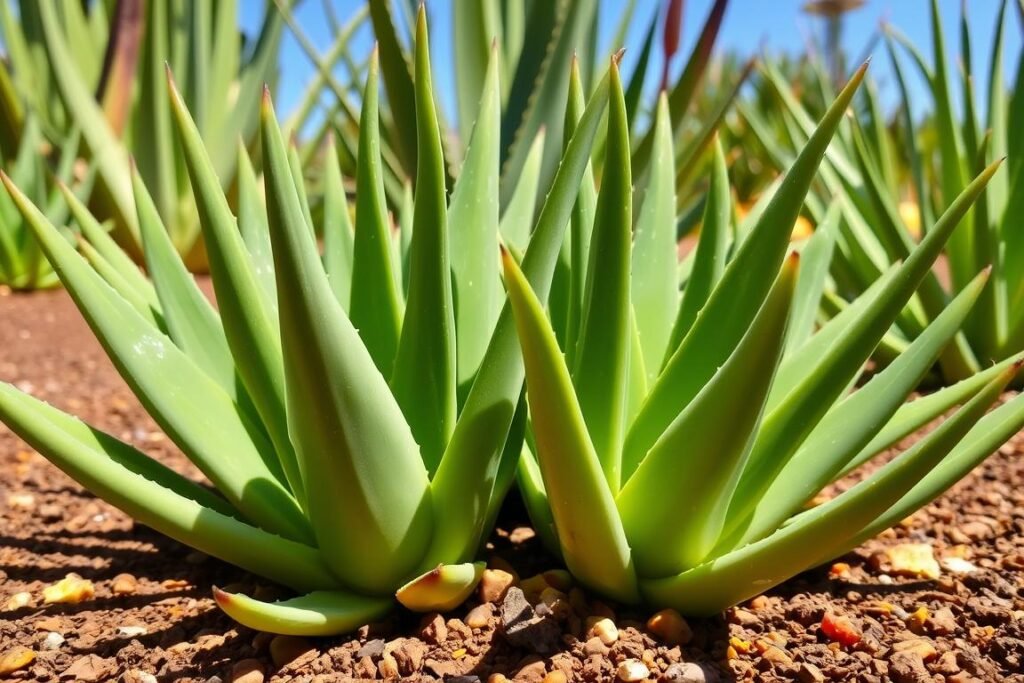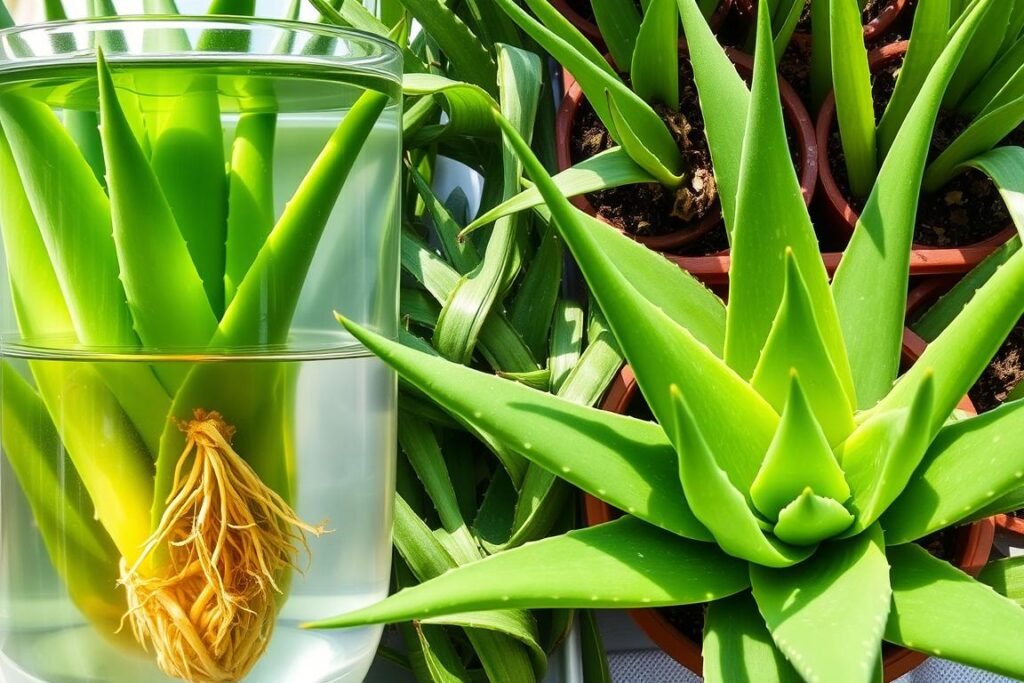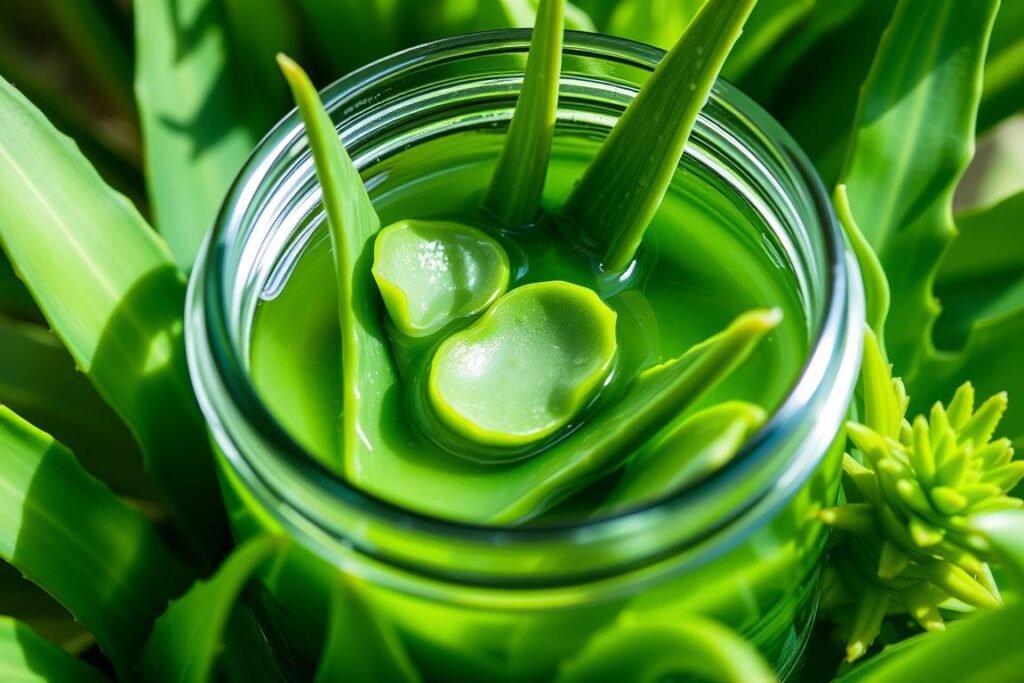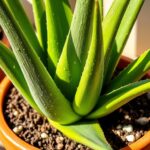I love gardening and the aloe vera plant is one of my favorites. It’s great for many things, like fixing sunburns and making skincare. But, can you grow it by putting leaves in water?
Putting aloe vera leaves in water might seem easy. But, it’s not the best way to grow them. Leaves often rot instead of growing roots.

The best way to grow aloe vera is by using offsets, or “pups.” They grow from the mother plant. This method works well and makes new plants that are just like the original.
Key Takeaways
- Rooting aloe vera leaves in water is not recommended as it often leads to rot before roots develop.
- Propagating aloe vera from pups (offsets) is the easiest and most successful method.
- Leaf cuttings can also be propagated in soil, but require more patience and care.
- Seed propagation is possible but slower and requires specific growing conditions.
- Aloe vera propagation is relatively quick compared to other plants, with new sprouts typically appearing in 4 to 6 weeks.
Understanding Aloe Vera Propagation Methods
Aloe vera is easy to grow from one leaf or offshoot. It can become a new plant in days. The Aloe barbadensis, or A. vera, is popular for its soothing gel. It helps with minor burns.
Starting new plants from leaves is not always reliable. But, you can root aloe vera cuttings and separate “pups” for new plants.
Traditional Propagation Techniques
Aloe vera can grow in several ways. You can use pups, leaf cuttings, or seeds. Pup propagation is the fastest and most reliable.
Leaf cutting works best in well-draining soil, not water. Seed propagation is slow but possible.
Benefits of Different Propagation Methods
- Pup propagation: Fastest and most reliable method, with established root systems.
- Leaf cutting propagation: Challenging but possible with care and patience.
- Seed propagation: Slow but can produce new aloe plants.
Essential Factors for Successful Propagation
For successful aloe vera growth, use well-draining soil. A cactus potting mix with perlite is best. Water carefully, letting the soil dry between waterings.
Give plants enough light, at least 8-10 hours of direct sunlight daily. Spring is the best time to propagate.
The process of propagating aloe plants is straightforward and suitable for indoor gardening beginners, with the ability to restart the project by using another leaf or pup if any issues arise.
Can I Root Aloe Vera Leaves in Water to Propagate
Rooting aloe vera leaves in water is not a good idea. Some plants can grow in water, but aloe vera is not one of them. Trying to root aloe leaves in water often makes them rot before they can grow roots.
It’s better to grow aloe vera in soil. You can separate the little plants from the mother plant. Or, you can use leaf cuttings, but they need special care to not rot.
Even though it might seem easy to root aloe leaves in water, it’s not the best way. Soil methods, like separating pups, work much better. They help aloe vera plants grow strong and healthy.
“Propagating aloe vera from seed requires specific soil, temperature, and light conditions typically found in a controlled greenhouse setup.”
Knowing how to propagate aloe vera is important. Trying to root leaves in water usually doesn’t work. Stick with soil methods, like separating pups, for the best results.
The Most Effective Way: Propagating Through Pups
Aloe vera is a popular houseplant that’s easy to grow. It’s known for simple propagation. The best way to do this is by propagating aloe plants from leaves using pups. Pups are small plants that grow at the base of the mother plant.
Identifying Healthy Pups
Healthy aloe pups are 3-4 inches tall. They have a few leaves and their own roots. Look for pups that are green and firmly attached to the mother plant.
When to Separate Pups from Mother Plant
It’s best to separate pups when they are 3-4 inches tall. This is usually in the spring or early summer. The aloe plant should be growing well at this time.
Step-by-Step Pup Separation Process
- Carefully remove the mother plant from its pot, exposing the base and pups.
- Gently separate the pups from the mother plant, ensuring that each pup has its own root system attached.
- If the pups do not have visible roots, allow them to callus over for a few days before planting.
- Repot the separated pups in a well-draining potting mix, such as a blend of 2 parts potting soil, 1 part pumice, and 1 part perlite.
- Water the newly potted pups sparingly, allowing the soil to dry out almost completely between waterings.
Propagating aloe vera through pups is a reliable method. It uses the plant’s natural ability to produce offsets. By following these steps, you can grow more aloe vera plants and share them with others.

Tools and Materials Needed for Aloe Propagation
To grow aloe plants, you need some basic tools and stuff. You can use these for rooting aloe vera leaf cuttings or for separating pups. Having the right tools makes it easier and faster.
You’ll first need a sharp, clean knife or pruning shears. Use clean, heat-treated stainless steel blades for clean cuts. Also, a good soil mix is key. Use a mix made for succulents or a mix of indoor soil with sand or perlite.
Sturdy pots with holes are important for the new plants. A rooting hormone can help with root growth and reduce shock. A moisture meter is also useful. It helps you know when the soil is too wet or dry.
| Essential Tools for Aloe Propagation | Description |
|---|---|
| Sharp, Sterilized Knife or Pruners | Clean, heat-treated stainless steel blades for making precise cuts |
| Well-Draining Soil Mix | Succulent or cactus potting mix, or a blend of indoor soil and coarse sand/perlite |
| Pots with Drainage Holes | Ensure proper drainage and aeration for newly propagated aloe plants |
| Rooting Hormone | Stimulates root growth and minimizes transplant shock |
| Moisture Meter | Helps monitor soil moisture levels to prevent over or underwatering |
With these tools and materials, you’re ready to grow aloe plants. You can try different methods like rooting leaf cuttings or separating pups.

Leaf Cutting Method: Pros and Cons
Propagating aloe vera plants through pup separation works best. But, using leaf cuttings is also good when pups are hard to find. This method uses thick, healthy aloe vera leaves to grow new plants.
Proper Cutting Techniques
Choose a thick, healthy leaf without any damage. Use a sharp knife to cut at a 45-degree angle near the base. This helps the leaf grow roots better.
Callusing Process
Let the cut end callus over for 2 to 4 days. This step makes a protective layer and prevents rot. Keep the leaf in a dry, warm spot, away from sunlight.
After callusing, cut the leaf into 2 to 4 inch pieces. Each piece should have a flat edge. Dip the cut ends in rooting hormone powder or gel. Then, plant them in soil that drains well.
The leaf cutting method takes longer to root than pup separation. But, it’s useful when pups are not around. It’s less reliable than pup separation, as cuttings might rot or not grow well.

Soil Requirements for Successful Propagation
To grow aloe plants, you need the right soil. It helps roots grow well and stops problems like root rot. Aloe vera likes soil that drains well and is sandy.
The best soil mix is half indoor potting soil and half coarse sand or perlite. This mix keeps the soil right for aloe plants. A little smart gravel helps too, keeping water from pooling.
Make sure your pots have big holes for water to drain. Aloe plants don’t like wet feet. Let the soil dry out before watering again.
| Soil Component | Proportion | Purpose |
|---|---|---|
| Indoor Potting Soil | 50% | Provides essential nutrients for plant growth |
| Coarse Sand or Perlite | 50% | Improves drainage and aeration |
| Smart Gravel | 10% (optional) | Further enhances drainage and soil structure |
Follow these tips to make great soil for your aloe plants. They will grow strong and healthy.
Optimal Growing Conditions for New Aloe Plants
Starting aloe vera plants is a great way to grow your indoor garden. It’s also a nice thing to share with friends. To help your new aloe plants grow well, you need to know what they like. They need the right light, temperature, and humidity to do well.
Light Requirements
Aloe vera plants love bright, indirect light. Start by giving them a little direct sunlight. This helps them get used to it without getting sunburned.
Temperature and Humidity Considerations
The best temperature for aloe vera is 65-80°F (18-27°C). Keep them in a warm, bright spot. They don’t like too much humidity. Make sure they have good air flow to stay healthy.
| Optimal Growing Conditions for Aloe Vera | Requirement |
|---|---|
| Light | Bright, indirect light |
| Temperature | 65-80°F (18-27°C) |
| Humidity | Low humidity |
| Soil | Well-draining, sandy soil |
| Watering | Allow soil to dry between waterings |
Give your new aloe plants the right conditions to grow strong. This way, you’ll get lots of aloe vera to enjoy.
Common Mistakes to Avoid During Propagation
Propagating aloe vera can be fun and rewarding. But, it’s key to avoid common mistakes for success. Whether you’re how to root aloe vera leaf cuttings or using the aloe vera leaf propagation method, knowing these mistakes can help a lot.
One big mistake is overwatering. Aloe vera plants can get root rot if the soil is too wet. Also, using soil that doesn’t drain well can cause the same problem.
When to propagate is also important. Don’t try it in winter when the plant grows slower. Spring and early summer are the best times because the plant is growing fast.
- Don’t put new plants in direct sunlight right away. It can stress and harm them.
- Make sure pups have enough roots and are big enough before separating them. If they’re too small or don’t have roots, they might not make it.
- Don’t use fertilizer on new plants until they start growing well and are settled.
By avoiding these mistakes, your aloe vera plants will grow strong and healthy. You’ll get to enjoy their beauty and benefits.
“Propagating aloe vera can be a rewarding experience, but it’s important to steer clear of common pitfalls to ensure your efforts are successful.”
Caring for Newly Propagated Aloe Plants
Congratulations on growing your aloe vera plants! Now, you have new aloe pups. It’s time to give them the right care for growth.
Water them carefully. Let the soil dry out before watering again. Water every 5-10 days, depending on the weather and soil.
Choose a bright, indirect spot for them. Start with less light and add more slowly. This helps them grow strong.
FAQ
Can I root aloe vera leaves in water to propagate?
No, it’s not good to root aloe vera leaves in water. They often rot before getting roots. It’s better to use offshoots (pups), seeds, or leaf cuttings in well-draining soil.
What are the traditional propagation techniques for aloe vera?
You can use pups, leaf cuttings, or seeds to grow aloe vera. Pups are the fastest and most reliable. Leaf cuttings work well in soil. Seeds are slower and need special care.
What are the benefits of the different aloe vera propagation methods?
Pup propagation is the best because it’s quick and reliable. Leaf cuttings are good when you don’t have pups. Seeds are slower and need special care.
What are the essential factors for successful aloe vera propagation?
For success, use well-draining soil and water right. Give them enough light and choose the right time to propagate. Spring is usually the best time.
How can I identify healthy pups for aloe vera propagation?
Healthy pups are small offshoots at the base of the mother plant. They should have a few leaves and be 3-4 inches tall. Make sure they have their own roots.
When is the best time to separate pups from the mother aloe vera plant?
Separate pups when they have a few leaves and are 3-4 inches tall. This is usually in the spring.
What is the step-by-step process for separating pups from the mother aloe vera plant?
First, remove the mother plant from its pot. Then, gently separate the pups. If they don’t have roots, let them callus before planting. Use well-draining soil and water sparingly.
What tools and materials are needed for aloe vera propagation?
You’ll need a sharp knife or pruning shears, well-draining soil, pots with holes, rooting hormone, and a moisture meter. Use a succulent potting mix or a mix of indoor soil and perlite.
What are the pros and cons of propagating aloe vera through leaf cuttings?
Leaf cuttings are less reliable than pups but useful when you don’t have pups. Choose a healthy leaf, cut it at a 45-degree angle, and let it callus. Then, plant it in well-draining soil. This method takes longer than pup propagation.
What type of soil is best for successful aloe vera propagation?
Use a well-draining soil mix for succulents. A mix of indoor soil and coarse sand or perlite works well. Adding smart gravel can help with drainage and aeration.
What are the optimal growing conditions for newly propagated aloe plants?
New aloe plants need bright, indirect light and a temperature of 65-80°F (18-27°C). They prefer low humidity. Gradually introduce them to direct sunlight and avoid overwatering to prevent fungal issues.
What are some common mistakes to avoid during aloe vera propagation?
Avoid overwatering and using poor soil. Don’t propagate at the wrong time or without allowing cuttings to callus. Don’t expose new plants to direct sunlight right away and don’t separate small pups without roots.
How should I care for newly propagated aloe plants?
Water them sparingly, letting the soil dry completely between waterings. Place them in bright, indirect light and gradually increase light. Use a balanced, diluted fertilizer when new growth appears. Watch for stress or disease and repot when needed.






